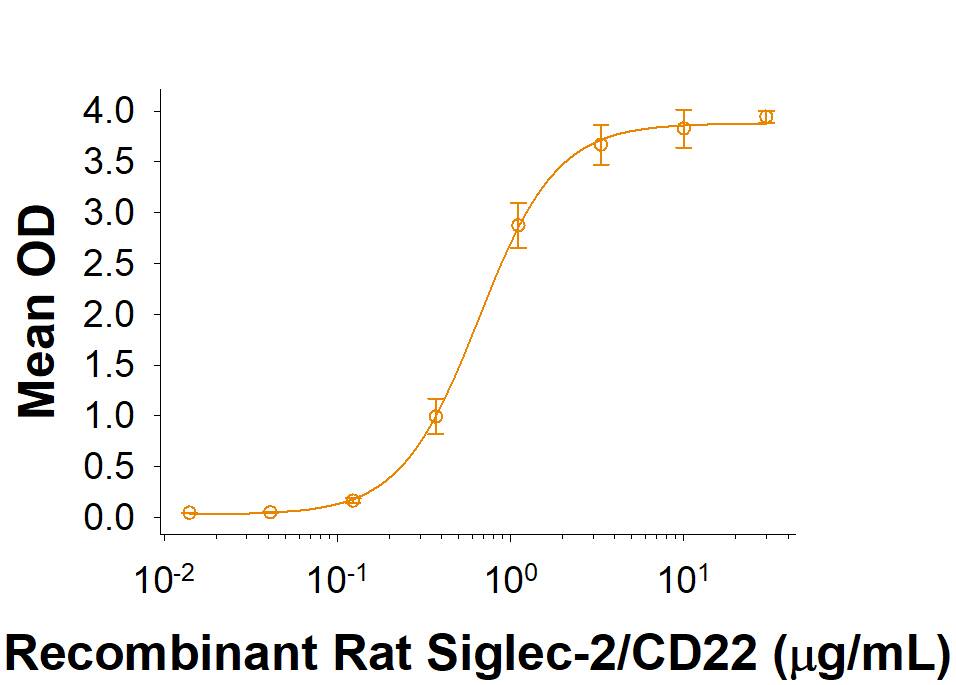Recombinant Rat Siglec-2/CD22 Fc Chimera Protein, CF
R&D Systems, part of Bio-Techne | Catalog # 10572-SL

Key Product Details
Product Specifications
Source
Chinese Hamster Ovary cell line, CHO-derived rat Siglec-2/CD22 protein
| Rat Siglec-2/CD22 (Trp24-Gly690) Accession # NP_001100973.1 |
IEGRMDP | Mouse IgG2a (Glu98-Lys330) |
| N-terminus | C-terminus |
Purity
>95%, by SDS-PAGE visualized with Silver Staining and quantitative densitometry by Coomassie® Blue Staining.
Endotoxin Level
<1.0 EU per 1 μg of the protein by the LAL method.
N-terminal Sequence Analysis
Trp24
Predicted Molecular Mass
102 kDa
SDS-PAGE
112-138 kDa, under reducing conditions
Activity
Measured by the ability of the immobilized protein to support the adhesion of human red blood cells.
The ED50 for this effect is 0.15-1.8 μg/mL.
The ED50 for this effect is 0.15-1.8 μg/mL.
Scientific Data Images for Recombinant Rat Siglec-2/CD22 Fc Chimera Protein, CF
Recombinant Rat Siglec-2/CD22 Fc Chimera Protein Bioactivity.
Recombinant Rat Siglec-2/CD22 Fc Chimera (Catalog # 10572-SL) supports the adhesion of human red blood cells. The ED50 for this effect is 0.15-1.8 μg/mL.Recombinant Rat Siglec-2/CD22 Fc Chimera Protein SDS-PAGE.
2 μg/lane of Recombinant Rat Siglec-2/CD22 Fc Chimera Protein (Catalog # 10572-SL) was resolved with SDS-PAGE under reducing (R) and non-reducing (NR) conditions and visualized by Coomassie® Blue staining, showing bands at 112-138 kDa and 220-280 kDa, respectively.Formulation, Preparation and Storage
10572-SL
| Formulation | Lyophilized from a 0.2 μm filtered solution in PBS with Trehalose. |
| Reconstitution | Reconstitute at 500 μg/mL in PBS. |
| Shipping | The product is shipped at ambient temperature. Upon receipt, store it immediately at the temperature recommended below. |
| Stability & Storage | Use a manual defrost freezer and avoid repeated freeze-thaw cycles.
|
Background: Siglec-2/CD22
References
- Sato, S. et al. (1996) Immunity. 5:551.
- Crocker, P.R. and A. Varki (2001) Trends Immunol. 22:337.
- Macauley, M.S. et al. (2014) Nature Rev Imm. 14:653.
- Stamenkovic, I. and B. Seed (1990) Nature 345:74.
- Collins, B.E. et al. (2004) Proc. Natl. Acad. Sci. 101:6104.
- Pluvinage, J.V. et al. (2019) Nature. 568:7751.
- Clark, E.A. et al. (2018) Front Immunol. 9:2235.
Long Name
Sialic Acid Binding Ig-like Lectin 2
Alternate Names
BL-CAM, CD22, Siglec2
Gene Symbol
CD22
UniProt
Additional Siglec-2/CD22 Products
Product Documents for Recombinant Rat Siglec-2/CD22 Fc Chimera Protein, CF
Product Specific Notices for Recombinant Rat Siglec-2/CD22 Fc Chimera Protein, CF
For research use only
